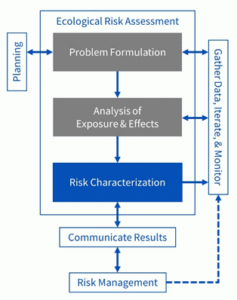Back to: Botany 500 Level
My Afrilearn champion, how your side?
Omo, today matter na correct one—Ecological Risk Assessment (ERA). As person wey dey study Botany, you gats sabi how to check danger wey fit reach plants, animals, soil or water before e spoil everywhere. Think am like when you dey test soup before you add salt—you dey prevent wahala before e happen. That na the koko of ERA!
Ecological risk assessment
Wetin Be Ecological Risk Assessment (ERA)?
ERA na the way scientists and environmental experts take check if one chemical, activity or project go harm living things (especially in the environment). E help us understand:

- Wetin fit cause harm
- Who or wetin go suffer am
- How bad the harm go be
- And wetin we fit do to stop or reduce am
Imagine say one factory dey pour waste for river—ERA go help us know if fish go die, if people fit still fetch that water, or if plants for that area go suffer.
Why ERA Dey Important?
- To protect biodiversity—make animals and plants no disappear
- To guide environmental policies and regulations
- To support decision-making before project or chemical use
- To prevent environmental disaster, like oil spills or pollution
- To make sure humans and ecosystems dey safe
Steps in Ecological Risk Assessment
- Problem Formulation:
This na where we define the wahala. Wetin we dey worry about? Maybe na pesticide for farmland or factory waste. We go also identify the organisms wey fit suffer—like frogs, fishes or trees. - Analysis Phase:
This step get two parts:
- Exposure Assessment: How dem go take reach the harmful thing? Through water, soil, or air?
- Effects Assessment: How strong the harm go be? E go kill the organism, stop growth, or disturb reproduction?
- Risk Characterisation:
Here we go combine all the findings to determine:
- The level of risk
- How serious the damage fit be
- And the likelihood say e go happen
- Risk Management & Communication:
This na when we decide on actions to reduce the risk. Maybe ban the chemical, clean the area, or restrict the activity. We go also inform the public, stakeholders and community.
Relatable Example (Nigerian Style):
Let’s say person dey use fertiliser near a river in Benue. ERA go check:

- If rain go wash the fertiliser enter river
- If e go affect fishes, aquatic plants or drinking water
- Whether e go affect local farmers wey dey use the water
Then dem fit suggest creating buffer zones or using eco-friendly fertilisers.
Summary:
- ERA na method to predict and reduce harm to the environment.
- E dey involve four main steps: Problem Formulation, Analysis, Risk Characterisation, and Management.
- E protect humans, animals, plants, water and soil from long-term damage.
- Very useful for project planning, farming, waste management and policy.
Evaluation:
- Define Ecological Risk Assessment.
- List the three main steps in the ERA process.
- Why is ERA important in project planning?
My Afrilearn brainbox, your future bright no be small!
You dey reason like environmental watchdog wey go use knowledge protect nature for Naija and Africa at large. Keep the fire burning, because every lesson you learn na one step closer to greatness. Onto the next jara lesson!
